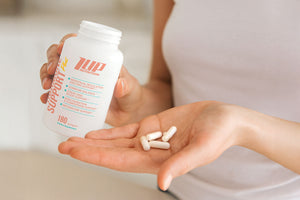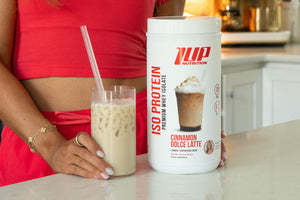Sodium is an essential mineral that plays a vital role in maintaining blood volume and blood pressure as well as nerve impulse transmission and muscle contraction.
The average person consumes upwards of 3,000mg of the electrolyte (usually in the form of table salt) each and every day![1]
Despite the widespread use and popularity of table salt, another sodium-containing salt is gaining traction with the masses, particularly those with an eye centered on health and fitness.
Join us as we discuss all things Pink Himalayan salt -- what is it, how it differs from regular table salt and does it confer any unique benefits above and beyond that of table salt.
What is Pink Himalayan Salt?
As the name suggests, Pink Himalayan salt is a pink-colored salt harvested from the Punjab region of Pakistan, near the Himalayas. Pink Himalayan salt is similar to table salt in that it contains 98% sodium chloride, but it also contains other important trace minerals, including calcium, potassium, and magnesium -- which table salt does not.
The two salts also differ in how they are processed.
Pink Himalayan salt is extracted by hand and minimally processed, yielding a product that is free of additives and fillers. Due to this, many consumers believe it to be “more natural” (“better”) than table salt.
Table salt, on the other hand, is mined from underground salt deposits and more heavily processed. Due to the extra processing involved, table salt loses many of its trace minerals. Furthermore, table salt usually has fillers and/or additives added to it to prevent clumping. Typical fillers added to table salt include calcium silicate, iodine (an important trace mineral essential to thyroid function), and dextrose (sugar).
Lastly, the two salts differ in the size of their crystals. Table salt, as you’ve seen for yourself, typically is very finely ground, whereas Pink Himalayan salt crystals are usually larger.
Due to the different size crystals, Pink Himalayan salt would deliver less sodium if you were to measure out a teaspoon of each, even though both contain ~98% sodium chloride. The reason for this is that table salt has a smaller, more finely ground crystals, meaning you can fit more of it in a given space.
Pink Himalayan Salt Claims and Benefits
Concomitant with the rise in popularity of Pink Himalayan Salt is the number of claims attributed to its use.
In no particular order, you’ll likely hear some of the following “benefits” when using Pink Himalayan Salt:
- Aids hydration
- Promotes a stable pH balance
- Reduces the signs of aging
- Boosts circulation
- Detoxifies the body
- Reduces muscle cramps
- Enhances libido
- Lowers blood pressure
Unfortunately, there is virtually no evidence for these claims, outside of what regular sodium has been shown to do in the body -- hydration, muscle function, nerve transmission, etc.
While it is true that Pink Himalayan salt does contain more trace minerals that table salt[2], remember that those additional trace minerals only account for ~2% of the mineral content of Pink Himalayan salt. The vast majority of Pink Himalayan salt consists of sodium chloride, which is what regular table salt is.
So, Is Pink Himalayan Salt Worth Using?
If you’re looking for a more natural salt alternative, Pink Himalayan salt is certainly a viable option as it is less processed and free of the additives found in regular table salt. Plus, it also contains numerous essential minerals which can complement your current nutrition plan.
However, it’s important to realize that many of the claims you will read about Pink Himalayan salt, are just that -- claims.
Lastly, if you are interested in swapping your table salt for Pink Himalayan salt, make sure to incorporate other dietary sources of iodine, as Pink Himalayan salt isn’t particularly rich in the trace mineral like table salt is.
References
- U.S. Department of Health and Human Services, U.S. Department of Agriculture. What We Eat in America. NHANES 2013–2014, Table 37. 2017.
- DRAKE, S. and DRAKE, M. (2011), COMPARISON OF SALTY TASTE AND TIME INTENSITY OF SEA AND LAND SALTS FROM AROUND THE WORLD. Journal of Sensory Studies, 26: 25-34. doi:10.1111/j.1745-459X.2010.00317.x






